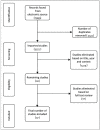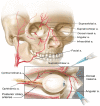Ophthalmic Complications of Periorbital and Facial Aesthetic Procedures: A Literature Review
- PMID: 37529817
- PMCID: PMC10388289
- DOI: 10.7759/cureus.41246
Ophthalmic Complications of Periorbital and Facial Aesthetic Procedures: A Literature Review
Abstract
The emergence and popularity of cosmetic facial procedures may lead to significant ophthalmic complications such as ocular motility dysfunction and visual disability. Here, we present a scoping review to identify common ophthalmic complications in some facial plastic surgeries and cosmetic injections, and to develop clinical approaches for prophylaxis and management in terms of direct attention and awareness of non-ophthalmologists toward such scenarios and appropriate intervention. This review was conducted according to the Preferred Reporting Items for Systematic Reviews and Meta-Analyses (PRISMA) guidelines. The following keywords were used to search PubMed, Scopus, Web of Science, and Google Scholar: "facial laser", "facial fillers", "facial injections", "hyaluronic acid", "local facial injections of botulinum toxin", "rhinoplasty", "blepharoplasty blindness", "ophthalmoplegia", "diplopia", "ptosis", "ophthalmic artery occlusion", "posterior ciliary artery occlusion", and "ocular ischemic syndrome". A total of 37 articles published between 1989 and 2021 were included, of which 21 were case reports. The most common ophthalmic complication was vision loss (0.0008%). The risk of ophthalmic complications including ocular pain, sudden unilateral or bilateral vision loss, flashes of light, ptosis, and ophthalmoplegia increase with injection in common anatomical regions like the glabella, nose, and supraorbital and nasolabial folds. The incidence of adverse events ranges from 5% to 18% in rhinoplasty. The most common complications after blepharoplasty were dry eye syndrome and diplopia, caused by eyelid ptosis. Eyelid, cornea, lens, and retina injuries are ophthalmic complications that occur after facial laser treatment. Ophthalmic complications after non-ophthalmic and cosmetic procedures are becoming increasingly common. The cumulative reported cases of ophthalmic complications after hyaluronic acid filler injection from 2016 to 2020 showed different types of adverse events, with the most common being decreased visual acuity, unilateral vision loss, and ptosis, with varying outcomes of each complication ranging from partial resolution to complete recovery. These complications must be recognized early, and prompt treatment must be established.
Keywords: facial fillers; facial injections; facial laser; hyaluronic acid filler; ocular; ophthalmic complications; procedures; rhinoplasty; surgeries.
Copyright © 2023, Alharbi et al.
Conflict of interest statement
The authors have declared that no competing interests exist.
Figures





Similar articles
-
Vision Loss Associated with Hyaluronic Acid Fillers: A Systematic Review of Literature.Aesthetic Plast Surg. 2020 Jun;44(3):929-944. doi: 10.1007/s00266-019-01562-8. Epub 2019 Dec 10. Aesthetic Plast Surg. 2020. PMID: 31822960
-
Sudden vision loss and neurological deficits after facial hyaluronic acid filler injection.Neurol Res Pract. 2022 Jul 18;4(1):40. doi: 10.1186/s42466-022-00203-x. Neurol Res Pract. 2022. PMID: 35850779 Free PMC article.
-
Severe vision loss caused by cosmetic filler augmentation: Case series with review of cause and therapy.J Cosmet Dermatol. 2018 Oct;17(5):712-718. doi: 10.1111/jocd.12705. Epub 2018 Jul 13. J Cosmet Dermatol. 2018. PMID: 30006992
-
The clinical spectrum of periorbital vascular complications after facial injection.J Cosmet Dermatol. 2021 May;20(5):1532-1540. doi: 10.1111/jocd.14019. Epub 2021 Mar 20. J Cosmet Dermatol. 2021. PMID: 33615645
-
Ocular Complications Following Autologous Fat Injections into Facial Area: Case Report of a Recovery from Visual Loss After Ophthalmic Artery Occlusion and a Review of the Literature.Aesthetic Plast Surg. 2017 Jun;41(3):580-584. doi: 10.1007/s00266-017-0805-3. Epub 2017 Feb 23. Aesthetic Plast Surg. 2017. PMID: 28233134 Free PMC article. Review.
Cited by
-
Expert Consensus on Ocular Safety During Laser Procedures: A Practical Guide to Eye Safety by a Panel of Dermatologist Laser Surgeons and Ophthalmologists.J Cosmet Dermatol. 2025 Jul;24(7):e70339. doi: 10.1111/jocd.70339. J Cosmet Dermatol. 2025. PMID: 40635643 Free PMC article.
-
Ophthalmic complications of injectable facial fillers.World J Clin Cases. 2024 Dec 6;12(34):6736-6739. doi: 10.12998/wjcc.v12.i34.6736. World J Clin Cases. 2024. PMID: 39650817 Free PMC article.
-
Upper Blepharoplasty for Dermatochalasis With or Without Resection of the Orbicularis Oculi Muscle, Preaponeurotic and Nasal Fat Pads: A Comparative Study.Aesthetic Plast Surg. 2025 Mar;49(6):1689-1696. doi: 10.1007/s00266-025-04657-7. Epub 2025 Jan 24. Aesthetic Plast Surg. 2025. PMID: 39856176 Free PMC article.
-
Role of Hyaluronic Acid in Post-Blepharoplasty Volume Restoration and Complication Management: A Systematic Review.J Clin Med. 2025 Jun 27;14(13):4572. doi: 10.3390/jcm14134572. J Clin Med. 2025. PMID: 40648944 Free PMC article. Review.
References
-
- Loss of vision after non-ophthalmic surgery: systematic review of the literature on incidence, pathogenesis, treatment and prevention (Article in German) Torossian A, Schmidt J, Schaffartzik W, Wulf H. Anaesthesist. 2006;55:457–464. - PubMed
Publication types
LinkOut - more resources
Full Text Sources
